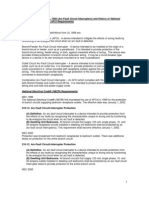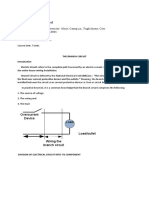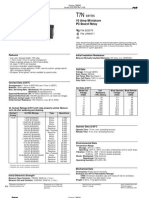0 ratings0% found this document useful (0 votes)
70 viewsArc-Fault Circuit Interrupters
Arc-Fault Circuit Interrupters
Uploaded by
Florabel Tolentino Sera Josefee
Copyright:
© All Rights Reserved
Available Formats
Download as PDF, TXT or read online from Scribd
Arc-Fault Circuit Interrupters
Arc-Fault Circuit Interrupters
Uploaded by
Florabel Tolentino Sera Josef0 ratings0% found this document useful (0 votes)
70 views6 pagesee
Copyright
© © All Rights Reserved
Available Formats
PDF, TXT or read online from Scribd
Share this document
Did you find this document useful?
Is this content inappropriate?
ee
Copyright:
© All Rights Reserved
Available Formats
Download as PDF, TXT or read online from Scribd
Download as pdf or txt
0 ratings0% found this document useful (0 votes)
70 views6 pagesArc-Fault Circuit Interrupters
Arc-Fault Circuit Interrupters
Uploaded by
Florabel Tolentino Sera Josefee
Copyright:
© All Rights Reserved
Available Formats
Download as PDF, TXT or read online from Scribd
Download as pdf or txt
You are on page 1of 6
Copyright 2001 Underwriters Laboratories Inc.
Arc-Fault Circuit Interrupters (AFCIs) -
Type and Performance Considerations
In February of 1999, UL published the First Edition of the Standard for Arc-Fault
Circuit-Interrupters (AFCIs), UL1699. According to the National Electrical Code
(NEC), an AFCI is defined as a device intended to provide protection from the
effects of arc faults by recognizing characteristics unique to arcing and by
functioning to de-energize the circuit when an arc fault is detected. The 2002
NEC will require all branch circuits that supply 125-volt, single-phase, 15- and
20-ampere outlets installed in dwelling unit bedrooms to be protected by an AFCI
listed to provide protection to the entire branch circuit.
Branch Circuits
A branch circuit is defined in Article 100 of the NEC as the circuit conductors
between the final overcurrent device protecting the circuit and the outlet(s). The
length of a branch circuit can vary from several feet to several hundred feet, and
include from one to several outlets. Figure 1 shows a pictorial representation of
a typical branch circuit that could be associated with a dwelling unit bedroom.
Figure 1 Pictorial Representation of a Typical Branch Circuit (Not to Scale)
Copyright 2001 Underwriters Laboratories Inc.
The branch circuit overcurrent protection is provided by a fuse or circuit breaker
usually located in a centralized panelboard that is served with power by the local
utility. As the name implies, overcurrent protection protects the branch circuit
against any currents that are in excess of the rated current or ampacity of the
branch circuit conductors. Overcurrents can be the result of overloads, short
circuits, or ground faults. Overcurrent protection is provided to open the circuit if
the current reaches a value that will cause an excessive or dangerous
temperature in the branch circuit conductors or conductor insulation.
The branch circuit conductors are normally contained within a non-metallic cable
(NM-B), armored cable (AC), or a metal or non-metallic raceway such as conduit
or tubing. Non-metallic cables and raceway systems contain a separate
conductor for equipment grounding purposes. Metal armor cables and raceways
may contain an equipment grounding conductor, but in most cases the metal
itself is permitted to serve as the equipment grounding path.
The branch circuit conductors extend throughout the building to outlets, which
may be a receptacle outlet for connecting to cord- and plug-connected
appliances, or to fixed equipment, such as a lighting outlet for a wall or ceiling
mounted lighting fixture (luminaire).
Receptacle outlets in the branch circuit provide for the connection of cord-
connected appliances, which in a bedroom may include appliances such as
portable lamps, clock-radios, and portable air heaters. The cords attached to
these appliances are generally referred to as power supply cords, as they supply
the power from the branch circuit to the cord-connected appliance. In some
cases, a power supply cord is not long enough to reach from the intended
location of the appliance to the nearest receptacle outlet. In these situations, a
cord set, often referred to as an extension cord, is used to extend the length of
the appliance power supply cord to the electrical outlet.
Cord sets and power supply cords are made from flexible cords that have
designations such as SPT-2 which is often used on portable lamps and light duty
extension cords. Although flexible cords are not a substitute for fixed branch
circuit wiring, they are tested for mechanical impact and flexural strength
properties that are suitable for their intended application. Flexible cords may or
may not be provided with an equipment grounding conductor depending on the
application or appliance involved. Cord sets and power supply cords are not part
of the branch circuit wiring, but since they extend power beyond the branch
circuit, they can be subjected to the same overloads, short circuits, and ground
faults as would the branch circuit wiring.
Branch Circuit Protection
The branch circuit overcurrent protective device (OCPD), (i.e. a fuse or circuit
breaker), is specifically designed to protect electrical circuits, including the
Copyright 2001 Underwriters Laboratories Inc.
branch circuit conductors and flexible cords, against the unwanted effects of
overcurrents. For example, when too many products are plugged into the same
electrical outlet, and the total load current exceeds the rating of the branch circuit
(i.e. 15 or 20 amps), the OCPD will open the circuit before damage to equipment
or a fire occurs. However, an OCPD is not designed to protect the circuit against
arcing faults. Because of the time-current characteristics of the OCPD necessary
to provide effective protection against overcurrents, some arcing faults, including
damaging arcing faults, may have time and/or current characteristics below the
threshold levels necessary to open the OCPD.
Arcing Faults
Arcing is defined as a luminous discharge of electricity across an insulating
medium. The electrical discharge of an arc can involve temperatures on the order
of several thousand degrees Celsius. In general, arcing can be divided into two
categories: (1) non-contact arcing and (2) contact arcing.
Non-contact arcing is arcing that does not require direct physical contact
between the conductors where the arcing is taking place. With arcing between
conductors separated by insulation, the mechanism of initiating an arc between
stationary conductors separated by insulation will depend on the type and
geometry of the conductors and insulation between them. Contact arcing is
arcing that involves direct or indirect physical contact between the conductors or
"electrodes" where the arcing is taking place, such as arcing between closing or
parting conductors making or breaking a circuit.
Arcing faults can occur in one of two ways, series arcing faults or parallel arcing
faults. A series arcing fault can occur when one of the current-carrying paths
(e.g. a single wire) in series with the load is unintentionally broken. For example,
extreme flexing in an appliance power supply cord can cause one of the
conductors to open and arc when flexed. Series arcing faults are limited in
current to the load current of the connected appliance or appliances in that
circuit. Parallel arcing faults occur when there is an unintentional conducting
path between two conductors of opposite polarity, such as between a black and
white conductor, or between a line conductor and ground. Parallel arcing faults
generally involve high currents, as they are limited only by the available fault
current of the circuit.
AFCI Types
The UL1699 Standard addresses several types of AFCIs. Each type of AFCI is
intended for different applications and/or protection of different aspects of the
branch circuit and extension wiring. Three types of AFCIs for permanent
connection to the branch circuit are identified in UL1699 as follows:
Copyright 2001 Underwriters Laboratories Inc.
Branch/Feeder AFCI This device is installed at the origin of a branch circuit
or feeder, such as at a panelboard, to provide protection of the branch circuit
wiring, feeder wiring, or both, against unwanted effects of arcing. This device
also provides limited protection to branch circuit extension wiring (e.g. cord
sets and power supply cords). These may be a circuit-breaker type devices
or a device in its own enclosure mounted at or near a panelboard.
Outlet Circuit AFCI This device is installed at a branch circuit outlet, such
as at an outlet box, to provide protection of cord sets and power-supply cords
connected to it (when provided with receptacle outlets) against the unwanted
effects of arcing. This device may provide feed-through protection of the cord
sets and power-supply cords connected to downstream receptacles.
Combination AFCI This is an AFCI which complies with the requirements
for both branch/feeder and outlet circuit AFCIs. It is intended to protect
downstream branch circuit wiring, cord sets and power-supply cords.
The NEC and AFCIs
During the revision process for the 2002 NEC there were several proposals to
revise Sec. 210-12 to require both a branch/feeder and outlet circuit AFCIs in
branch circuits required to be protected (bedrooms). This would provide
protection to both the branch circuit wiring, as well as cord sets and power supply
cords that extend beyond the branch circuit. The Code Panel did not accept
these proposals. There was also a proposal for the 2002 NEC to permit either a
branch/feeder AFCI located at the origin of the branch circuit, or a new type of
AFCI designated an outlet branch circuit type located at the first outlet
receptacle. A proposed revision to UL1699 would include this new type of AFCI
defined as follows:
Outlet Branch Circuit AFCI A device intended to be installed as the first
outlet in a branch circuit. It is intended to provide protection to downstream
branch circuit wiring, cord sets and power-supply cords against the unwanted
effects of arcing. These devices also provide protection to upstream branch
circuit wiring.
The final language agreed upon by the Code Panel for the 2002 NEC for Sec.
210.12 will indicate the following: All branch circuits that supply 125-volt, single-
phase, 15- and 20-ampere outlets installed in dwelling unit bedrooms shall be
protected by an arc-fault circuit interrupter listed to provide protection to the
entire branch circuit.
Copyright 2001 Underwriters Laboratories Inc.
AFCI Tests
As the UL1699 Standard continues to develop and address different product
types and technology enhancements, it is important to understand how each type
of AFCI is suitable for protecting various regions of the entire circuit against arc
faults, and the extent and conditions under which this protection will be provided.
Four different arc-fault tests are identified in UL1699 as shown in Figure 2.
Tests Branch/
feeder
AFCI
Combination
AFCI
Outlet branch
circuit
AFCI
Carbonized path arc ignition test <series>
NM-B insulation cut X X X(+)
<new> NM-B w/o gnd insulation cut X(+)
Carbonized path arc interruption test <parallel>
SPT-2 insulation cut X X X
NM-B insulation cut X X X
Carbonized path arc clearing time test <series>
SPT-2 insulation cut X X
<new> NM-B insulation cut X(+)
Point contact arc test <parallel>
SPT-2 insulation cut X X X
NM-B insulation cut X X X
(+) also includes an upstream insulation cut
Figure 2 AFCI Arc-Fault Tests
The Carbonized Path Arc Ignition Test is a non-contact arcing test conducted
with NM-B cable with a series insulation cut. Tests are conducted with arcing
currents of 5 A, 10 A, rated current, and 150% rated current. The
Branch/Feeder, Combination, and Outlet Branch Circuit AFCIs are subjected to
the Carbonized Path Arc Ignition Test. The Outlet Branch Circuit AFCI is
subjected to the Carbonized Path Arc Ignition Test with the arcing occurring
upstream, to represent series arcing in the branch circuit wiring between the
origin of the branch circuit and the first outlet receptacle. The Outlet Branch
Circuit AFCI is also subjected to the Carbonized Path Arc Ignition Test using NM-
B cable without a grounding conductor, as may be found in some older homes
built over 40 years ago.
The Carbonized Path Arc Interruption Test is a non-contact arcing test conducted
with NM-B cable and SPT-2 flexible cord with a parallel insulation cut. Tests are
conducted with arcing currents of 75 A and 100 A. The Branch/Feeder,
Combination, and Outlet Branch Circuit AFCIs are subjected to the Carbonized
Copyright 2001 Underwriters Laboratories Inc.
Path Arc Interruption Test, however, the Outlet Branch Circuit AFCI is not tested
with this parallel arcing occurring upstream from the device.
The Carbonized Path Arc Clearing Time Test is a non-contact arcing test
conducted with SPT-2 flexible cord with a series insulation cut. Tests are
conducted with arcing currents of 5 A, 10 A, rated current, and 150% rated
current. The Outlet Branch Circuit and Combination AFCIs are subjected to the
Carbonized Path Arc Clearing Time Test. The Branch/Feeder AFCI is not
subjected to this series arcing test with flexible cord as found in many cord sets
and power supply cords. The Outlet Branch Circuit AFCI is subjected to the
Carbonized Path Arc Clearing Time Test with NM-B cable and the arcing
occurring upstream, to represent series arcing in the branch circuit wiring
between the origin of the branch circuit and the first outlet receptacle.
The Point Contact Arcing Test is a contact arcing test conducted with NM-B
cable and SPT-2 flexible cord with a parallel insulation cut. Tests are conducted
with arcing currents of 75 A through 500 A. The Branch/Feeder, Combination,
and Outlet Branch Circuit AFCIs are subjected to the Point Contact Arcing Test,
however, the Outlet Branch Circuit AFCI is not tested with this parallel arcing
occurring upstream from the device.
Further Information
For more information on AFCIs, see the Regulators Page on the UL Web site at:
http://www.ul.com/regulators/afci/index.html
You might also like
- Wiring Kingair 200 SeriesDocument1,921 pagesWiring Kingair 200 SeriesPedro Camargo88% (8)
- Introduction to Power System ProtectionFrom EverandIntroduction to Power System ProtectionRating: 4 out of 5 stars4/5 (2)
- Solution Manual To Chapter 02Document11 pagesSolution Manual To Chapter 02Shreya RameshNo ratings yet
- Protection of SubstationDocument21 pagesProtection of SubstationARVIND100% (3)
- 8051 ProgrammeDocument7 pages8051 ProgrammeSiva PNo ratings yet
- Electrical Code® (NEC®) AFCI RequirementsDocument3 pagesElectrical Code® (NEC®) AFCI RequirementssarenjithNo ratings yet
- Electrical WiringDocument11 pagesElectrical WiringRasydan AliNo ratings yet
- TVE 1st Quarter ReviewerDocument12 pagesTVE 1st Quarter ReviewerGaming DeathNo ratings yet
- Part 2 - Materials & MethodsDocument49 pagesPart 2 - Materials & MethodsBrena May PangandianNo ratings yet
- Protective Device A SwtichgearDocument24 pagesProtective Device A SwtichgearVarun Ghagare 03No ratings yet
- Chapter-1 Power DistributionDocument43 pagesChapter-1 Power Distributionrajendra88No ratings yet
- OVP Literature 200006Document6 pagesOVP Literature 200006vbraoNo ratings yet
- Ei Nvq2 Ch06Document32 pagesEi Nvq2 Ch06Nihar RoyNo ratings yet
- CH 2Document32 pagesCH 2tekeba lakeNo ratings yet
- Protection of SubstationDocument21 pagesProtection of Substationkvramanan_1100% (2)
- Electrical Wiring in The United Kingdom - WikipediaDocument17 pagesElectrical Wiring in The United Kingdom - WikipediasorinproiecteNo ratings yet
- Data Bulletin Arc-Fault Circuit Interrupters For NQ PanelboardsDocument2 pagesData Bulletin Arc-Fault Circuit Interrupters For NQ PanelboardsJesus VelascoNo ratings yet
- Electrical V 2.0Document65 pagesElectrical V 2.0hahadu0% (1)
- Group 2 - Electrical DevicesDocument17 pagesGroup 2 - Electrical Devicesar.ananeustNo ratings yet
- Lab ManualDocument96 pagesLab ManualASWANI RAJAN50% (2)
- Basic Electrical Wiring ReviewerDocument4 pagesBasic Electrical Wiring ReviewerRoselyn CantosNo ratings yet
- CONDUCTORS - Are Materials Which Allow The Free FloDocument7 pagesCONDUCTORS - Are Materials Which Allow The Free Flobeaburga5No ratings yet
- Cable Engineering in Substation and Power PlantDocument7 pagesCable Engineering in Substation and Power PlantVasudev AgrawalNo ratings yet
- Siemens Power Engineering Guide 7E 37Document1 pageSiemens Power Engineering Guide 7E 37mydearteacherNo ratings yet
- Switchyard FinalDocument6 pagesSwitchyard FinalPritam SamantaNo ratings yet
- LDA Handbook EN - Speaker-Line-Wiring v2Document7 pagesLDA Handbook EN - Speaker-Line-Wiring v2Atif BhandaraNo ratings yet
- 11 KV SUBSTATION (Notes)Document27 pages11 KV SUBSTATION (Notes)Md Ariful Islam100% (1)
- 162 - BEC206 - IEN00933 - 6496 - 2 - 8.0 Power Systems and EquipmentDocument29 pages162 - BEC206 - IEN00933 - 6496 - 2 - 8.0 Power Systems and EquipmentAnonymous HuXlGlzkNo ratings yet
- Arc Guided Protection Devices: Aishwarya RaviDocument22 pagesArc Guided Protection Devices: Aishwarya RaviAishwarya RaviNo ratings yet
- Back To Basics - Conductors, Currents and Circuit Protection - IAEI MagazineDocument13 pagesBack To Basics - Conductors, Currents and Circuit Protection - IAEI MagazineMORALES2197No ratings yet
- Lightning Protection and Power Quality: Application NoteDocument2 pagesLightning Protection and Power Quality: Application NoteJefferson AndrésNo ratings yet
- Bu 2Document6 pagesBu 2Nerinel CoronadoNo ratings yet
- Isolation TransformerDocument6 pagesIsolation TransformerVaibhav AryaNo ratings yet
- Importante Not About Transformer Isolation - WikipediaDocument3 pagesImportante Not About Transformer Isolation - Wikipediamehdi JrNo ratings yet
- FFFFFFFDocument12 pagesFFFFFFFvirgilio ayadNo ratings yet
- Lightning Arrester: Arrestor) (Also Called Lightning Diverter) Is A Device UsedDocument4 pagesLightning Arrester: Arrestor) (Also Called Lightning Diverter) Is A Device UsedSanjaybsNo ratings yet
- EE114 1 Homework 2Document3 pagesEE114 1 Homework 2Denver John TejadaNo ratings yet
- Cable Spacing As A Means of Noise Mitigation: Separation DistancesDocument4 pagesCable Spacing As A Means of Noise Mitigation: Separation DistancesManuel Henríquez SantanaNo ratings yet
- Module6 (Electrical Installations)Document17 pagesModule6 (Electrical Installations)Sourabh PaulNo ratings yet
- Isolation TransformersDocument9 pagesIsolation TransformersAdrian Enrique MaldonadoNo ratings yet
- Protection of SubstationDocument21 pagesProtection of SubstationDivyanshu Agarwal50% (2)
- CEACDocument5 pagesCEACJov AprisNo ratings yet
- Circuit Protection Devices: Figure 10-1Document30 pagesCircuit Protection Devices: Figure 10-1deep4u2009No ratings yet
- Finals Module 1 2 Avt 4232Document54 pagesFinals Module 1 2 Avt 4232angeloNo ratings yet
- Working of Lightning ArresterDocument5 pagesWorking of Lightning ArresterMd Gaffar KhanNo ratings yet
- Arc-Fault Circuit InterruptersDocument2 pagesArc-Fault Circuit InterruptersEdul Brian100% (1)
- Experiment No-6 SGPDocument21 pagesExperiment No-6 SGPSaroj kumar BiswasNo ratings yet
- SUN ReportDocument10 pagesSUN Reportpratham sutharNo ratings yet
- 1.12 Overcurrent Protective DevicesDocument62 pages1.12 Overcurrent Protective DevicesChristian MuliNo ratings yet
- PVC & Metal Conduits Casing & Capping System Panel Boards Switches Distribution BoardsDocument15 pagesPVC & Metal Conduits Casing & Capping System Panel Boards Switches Distribution Boardsmelvinmathewp044No ratings yet
- MSAN-139: Protection Networks For Telecommunications SystemsDocument8 pagesMSAN-139: Protection Networks For Telecommunications Systemsseyed mohammadNo ratings yet
- ELECTRICAL MATE WPS OfficeDocument16 pagesELECTRICAL MATE WPS Officepauasejo17No ratings yet
- Instrument Earthing System Shall Consist of The Following Earth TypeDocument6 pagesInstrument Earthing System Shall Consist of The Following Earth TypeTam TranNo ratings yet
- Electrical ProtectionDocument52 pagesElectrical ProtectionTi HidiNo ratings yet
- Introduction To Electrical System: Mariano, Jack M Bs Architecture 3 - DDocument10 pagesIntroduction To Electrical System: Mariano, Jack M Bs Architecture 3 - DJack MarianoNo ratings yet
- Electrical House WiringDocument27 pagesElectrical House WiringMary JennyNo ratings yet
- Types of Cable Typically Used in Cable Tray - Cable Tray InstituteDocument4 pagesTypes of Cable Typically Used in Cable Tray - Cable Tray InstitutezhangyiliNo ratings yet
- Cabletrays Institute Technical Bulletin15 PDFDocument3 pagesCabletrays Institute Technical Bulletin15 PDFjayabalkcetNo ratings yet
- ECM346 1.2.3 Function of Protection Devices HBI 02Document50 pagesECM346 1.2.3 Function of Protection Devices HBI 02Tiffany's LoveNo ratings yet
- EE114-1 Homework 2Document2 pagesEE114-1 Homework 2GuiaSanchezNo ratings yet
- BASIC Elec. TermsDocument5 pagesBASIC Elec. TermsRamces SolimanNo ratings yet
- FFFFFFFDocument6 pagesFFFFFFFvirgilio ayadNo ratings yet
- Residential Electrical Inspections - FLDocument12 pagesResidential Electrical Inspections - FLFlorabel Tolentino Sera JosefNo ratings yet
- CHN Lecture 082217Document43 pagesCHN Lecture 082217Florabel Tolentino Sera JosefNo ratings yet
- Variable Speed Pumping, A Guide To Successful ApplicationDocument6 pagesVariable Speed Pumping, A Guide To Successful Applicationongjoel0% (1)
- 2007 Code Breakfast Q&ADocument5 pages2007 Code Breakfast Q&AFlorabel Tolentino Sera JosefNo ratings yet
- DOE Strategic Plan - 2012 GPRA AddendumDocument5 pagesDOE Strategic Plan - 2012 GPRA AddendumFlorabel Tolentino Sera JosefNo ratings yet
- Top 12 Changes 2014 NECDocument2 pagesTop 12 Changes 2014 NECFlorabel Tolentino Sera JosefNo ratings yet
- OSHA Safety Rules - KYDocument1 pageOSHA Safety Rules - KYFlorabel Tolentino Sera JosefNo ratings yet
- RAP Schwartz RPSpresentationOSU 2010-2-22Document25 pagesRAP Schwartz RPSpresentationOSU 2010-2-22Florabel Tolentino Sera JosefNo ratings yet
- Key Lessons About Market-Based Mechanisms 市场机制的主要经验教训: David Crossley, Senior Advisor, RAP David Crossley,高级顾问,RAPDocument23 pagesKey Lessons About Market-Based Mechanisms 市场机制的主要经验教训: David Crossley, Senior Advisor, RAP David Crossley,高级顾问,RAPFlorabel Tolentino Sera JosefNo ratings yet
- RAP GlobalTransmissionPractices 2013 DECDocument83 pagesRAP GlobalTransmissionPractices 2013 DECFlorabel Tolentino Sera JosefNo ratings yet
- RAP Hogan WhatLiesBeyondCapacityMarkets 2012 AUG 14Document22 pagesRAP Hogan WhatLiesBeyondCapacityMarkets 2012 AUG 14Florabel Tolentino Sera JosefNo ratings yet
- Rap Sedano CHP Gatech 2013 Dec 4Document19 pagesRap Sedano CHP Gatech 2013 Dec 4Florabel Tolentino Sera JosefNo ratings yet
- RAP IssuesLetter-ElectricalEnergySecurityPolicies 2002 04Document8 pagesRAP IssuesLetter-ElectricalEnergySecurityPolicies 2002 04Florabel Tolentino Sera JosefNo ratings yet
- Regulatory Assistance Project Electric Resource Long-Range Planning SurveyDocument8 pagesRegulatory Assistance Project Electric Resource Long-Range Planning SurveyFlorabel Tolentino Sera JosefNo ratings yet
- ASX-560 Series Autosamplers Safety Manual AveryDocument102 pagesASX-560 Series Autosamplers Safety Manual AveryCENTEC ARAUCONo ratings yet
- Vocal ProcessingDocument1 pageVocal Processinghtperkins49No ratings yet
- Key Phaser FunctionDocument3 pagesKey Phaser Function586301No ratings yet
- Sound Eklin MarkXDocument13 pagesSound Eklin MarkXInstrulife OostkampNo ratings yet
- Web CD EU-01 Machine Case Study HFFS Pouch PMI06 v3Document4 pagesWeb CD EU-01 Machine Case Study HFFS Pouch PMI06 v3Justine IugaNo ratings yet
- Accurate - Wide - Range - Design - Equations - For MicrostripDocument8 pagesAccurate - Wide - Range - Design - Equations - For MicrostripLarry StellNo ratings yet
- Foxboro DCS: FBM201/b/c/d Analog Input (0 To 20 Ma, 0 To 100 MV, 0 To 5 V, 0 To 10 V DC)Document17 pagesFoxboro DCS: FBM201/b/c/d Analog Input (0 To 20 Ma, 0 To 100 MV, 0 To 5 V, 0 To 10 V DC)Juliano CappelleteNo ratings yet
- SFRA Quickstart GuideDocument4 pagesSFRA Quickstart GuideNeelakandan Masilamani100% (1)
- User's Guide MR2003B/D: 2. Quick-Start ChecklistDocument9 pagesUser's Guide MR2003B/D: 2. Quick-Start ChecklistStefán Þór SigurðssonNo ratings yet
- HW 9Document3 pagesHW 9pskumarvlsipdNo ratings yet
- Power Drop Product ManualDocument4 pagesPower Drop Product Manuallindodominguez100% (1)
- 909 - User ManualDocument326 pages909 - User ManualMiguel Ignacio Roman BarreraNo ratings yet
- In PowerDocument3 pagesIn Powersyamsudin4077No ratings yet
- IEC 60127-1 - Definitions For Miniature Fuses and General Requirements For Miniature Fuse-LinksDocument27 pagesIEC 60127-1 - Definitions For Miniature Fuses and General Requirements For Miniature Fuse-LinksMartin FierroNo ratings yet
- Digital Electronics Assignment-2022Document4 pagesDigital Electronics Assignment-2022JackKulchNo ratings yet
- C57 98-1993 PDFDocument59 pagesC57 98-1993 PDFEdwin CapdepomtNo ratings yet
- Relay 5vDocument2 pagesRelay 5vNgoc Loi Nguyen HoNo ratings yet
- ETCE SYLLABUS Jadavpur UniversityDocument40 pagesETCE SYLLABUS Jadavpur UniversityDipayan DasNo ratings yet
- Release 6.0: Technical Solution ManualDocument5 pagesRelease 6.0: Technical Solution ManualcosconorNo ratings yet
- Img 1798102Document64 pagesImg 1798102khairrul amry romliNo ratings yet
- Manual-DAIKIN Oil Cooling Unit AKZJ8 Series - AKZJ8 Manual - English PIM00132ADocument44 pagesManual-DAIKIN Oil Cooling Unit AKZJ8 Series - AKZJ8 Manual - English PIM00132Atimnuatrongtoi077No ratings yet
- CQ Amateur Radio 06-2019Document116 pagesCQ Amateur Radio 06-2019testNo ratings yet
- 2016 - 01 - 22 - Principle Process Layout PT - ConveyorDocument2 pages2016 - 01 - 22 - Principle Process Layout PT - ConveyorcristiNo ratings yet
- Vdocuments - MX Idirect Link Budget Analysis GuideDocument18 pagesVdocuments - MX Idirect Link Budget Analysis GuideCarlosRivasNo ratings yet
- 750 Programming 102010Document83 pages750 Programming 102010Ehsan Rohani100% (1)
- Georgoulopoulos 2019Document4 pagesGeorgoulopoulos 2019eviteNo ratings yet
- 93c26-A KR BS La PR PDFDocument58 pages93c26-A KR BS La PR PDFronoro450No ratings yet







































































































